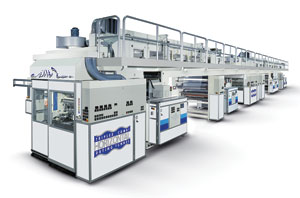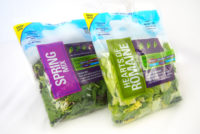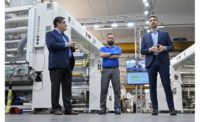
|
| Triplex Combi Horizontal is a high-end coater laminator for flexible packaging applications, which allows for three layers lamination or two layers lamination, and one coating application in a single pass, using a variety of coating technologies as allowed by the Nordmeccanica signature interchangeable coating head design. |
commercial director
Nordmeccanica SpA
10 years with the company
+39 0523 596411
Michael D’Angelo
vice president
Bobst
30 years with the company /14 years in the industry
(888) 226-8800
Q: Please explain coating onto flexible film substrates in a few steps. Separately, please explain the typical steps of laminating a flexible film substrate. (If they go hand-in-hand, please explain the tie-in.)
Caimmi: Coating on flexible is about a deposition of a substance on a substrate that is not rigid. It may seem like an elementary definition, but the key word “deposition” is very difficult to represent. How is it done?
With a quick flashback to the early days we may be able to focus on the two main streams of technologies that required some sort of deposition: textile, and paper industry. In textile it was mainly about coating wax for water proofing (the oilskin). In the paper industry, it was substantially an evolution of print. The target was to print/coat a roll of paper with great speed advantages in comparison to the initial design that was about sheet printing. Initially it was about 100 percent solid: wax.
It was used for an array of applications from adhesion to water proofing. Then, with the development of the “vehicle” technology or the ability to dilute/disperse a resin into a liquid, the technology expanded into other applications.
The coating technology was born primarily by soaking a substrate into melted wax; the need to control the amount of coating influenced the rest of the evolution, basically running side to side with the evolution of rotary presses. New substrates presented to the industry as cellophane and synthetic polymers, allowed for the final expansion of the technology with the multiple applications we know at these days. The process of coating can be simplified into a few steps: handling a layer of a substrate; bring it into a coating station; apply a substance to it; properly provide to calibrate the amount of coating.
The coating technology is influenced by the nature of the substance to coat. In function of the viscosity at the coating head, there are a variety of alternative designs that will allow for a proper handling; the primary target being to properly dose the applied quantity.
Once the ability to apply a substance onto a substrate was mastered, then came another important evolution of the industry: lamination. Lamination of flexible substrates is the technology that will glue together layers of different substrates with the aim to complete a compound featuring the combined characteristics of all substrates involved. Process can be represented as the application of an adhesive onto a primary substrate and the lamination, into a pressure nip, to a secondary substrate, repeat unit completion of the number of layers required.
D’Angelo: On our machines, coating on film is realized by coating lacquer, or cold seal, as follows:
- Full coverage coating for print protection
- Full coverage coating to increase the barrier effect
- Full coverage heat seal to get sealing capacity on plastic material
- Cold seal coating in register on pre-printed material, to get sealing capacity in specific areas of the substrate
- The above coating types can be performed with both rotogravure and semi-flexo systems.
- On our machines, laminating on film is realized by coating adhesives on film with subsequent lamination to another substrate. Adhesives used can be solvent-based, water-based or solventless. The coating systems are for:
- Solvent-based: rotogravure and flexo systems
- Water-based: rotogravure system
- Solventless: 5-rollers system
In particular, flexo has been shown to achieve the best results by coating solvent-based adhesives on thin aluminium.
Final laminated product can be composed of two to four substrates, according to the characteristics needed on the final product (i.e. barriers to oxygen and humidity, UV protection, mechanical resistance).
Q: Which is your most popular type of coating for films? In what applications is this type of coating typically used?
Caimmi: Coating on film covers is by far the largest number of applications in the industry. In flexible packaging the most used coating technology is adhesive lamination.
In lamination, the target is to generate a compound that will feature the combined characteristics of all substrates involved: light barrier, gas barrier, mechanical strength, puncture resistance, chemical resistance, etc. Therefore, in a typical flexible packaging application, it will be possible to generate a combination of layers that will allow for formulating a package exactly tuned to the specific characteristics of the product to pack. All of the above feature those advantages that made flexible packaging successful: cost, energy saving, lightweight, reduction of volumes in landfill, etc.
D’Angelo: All previously mentioned applications are included in our production range. Solventless is the most popular, mainly for food packaging.
Q: Which is your most popular type of laminating for films? In what applications is this type of lamination typically used?
Caimmi: The most popular application for lamination in the industry, based on a number of installations, is definitely print protection. It is the primary reason to laminate, and is used starting with the simplest packaging application up to the most complex multi-layers compounds. It is about trapping the printed layer between two layers of substrates. The first layer will be the printed one; the second layer, a transparent film, will be applied above the printed layer to protect from scratches and other mechanical/chemical/UV damages.
Among lamination technologies for flexible packaging, solvent-less lamination is definitely the faster-growing and, perceptually wise and the most used. It is about the use of 100 percent solid adhesives, chemically cured. The technology, while requiring properly developed machinery, features the most operator-friendly approach, limits the investment on capital equipment, allows for very low energy consumption and no emissions.
D’Angelo: All applications are included in our production range. Solventless is the most popular. Mainly for food packaging and specific industrial application.
Moreover, our product range includes lamination through extrusion coating.
Q: Speaking specifically about coating and laminating onto flexible films, where do you believe the industry could improve?
Caimmi: Coating and laminating are the money shots in the flexible packaging and converting industry, allowing converters to add value to products and to run into segments where competition is lower and profit is higher. In general, in the industry and in North America in particular, there is a vast territory for improvements. Lamination capacity is still short and coating applications are still limited to a small number of converters. Technologies such as cold-seal coating, anti-fog coatings, in-register coatings in general, barrier coatings, etc., are these days, at reach for every shop. Technologies that are modern equipment are very easy to handle.
D’Angelo: The industry could improve in the adhesive/lacquer market with the aim to reduce the environmental impact (i.e. compostable film, inks, lacquers and adhesives).
Q: What’s missing from this sector?
Caimmi: In North America, as I mentioned, definitely capacity, especially in the high-level segment such as the one of the multi-layer structures, as testified by the percentage of import from developed countries.



